
20 Types Of Sucker Fish You Should Know

Writer at The Aquarium Keeper
Sucker fish can be quite useful in an aquarium in a lot of different ways. People like these types of fish, because they tend to stick to glass, and clean algae off of everything. There are a lot of different types of sucker fish available in the hobby, some are smaller, while others require larger tanks and more knowledge to keep.
What Fish Are Considered Sucker Fish?
Not all aquatic species fall into the suckermouth fish category. A species is considered sucker fish only, if they have a certain type of mouth. Sucker fish have a “suckermouth” which basically allows these species to suck on things, and attach to surfaces. For example, sucker fish tend to stay on aquarium glass, because they have the capability to suction themselves on it, similar to snails.
Most sucker fish species tend to be bottom-dwellers, which are basically fish, that spend most of their time at the bottom of the aquarium. Sucker fish love to attach to different surfaces, including aquarium glass, driftwood, rocks, and even plants. Most sucker fish come from different habitats and need different needs to happily live.
Types of Sucker Fish
In this list, you might find some rare types of sucker fish, that are quite expensive in this hobby, but also discover some basic fish, that you can find in any aquatic store. If you decide to get any of these suckermouth fish, be sure to carefully check what kind of requirements they need in order to successfully thrive.

Otocinclus
Firstly, the smallest sucker fish on this list, which is quite popular in this hobby is the otocinclus. These are very social creatures, that love their own kind and like to be in schools of at least 6. They are also a fish species that burrow in the sand, they do that when feeling threatened.
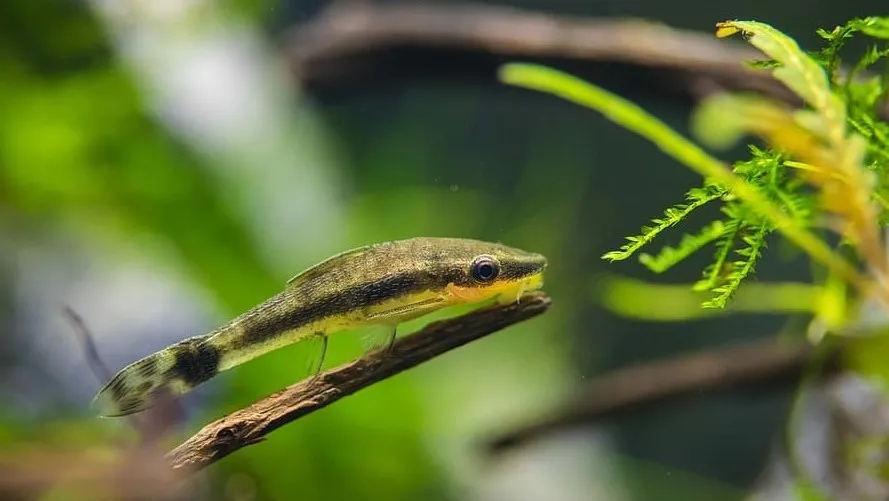
Otocinclus catfish are very tiny suckermouth species, that only reach up to 2.5 inches. They are excellent algae cleaners and will make your aquarium look better without all the random algae everywhere. They are grey in color and have a distinctive black stripe going across their whole body, from head to tail.
| Aspect | Information |
|---|---|
| Scientific Name | Otocinclus spp. |
| Origin | South America |
| Rarity | Common |
| Price | $2 - $5 USD |
| Care Level | Easy |
| Water Temperature | 21°C - 26°C (70°F - 79°F) |
| pH | 6.5 - 7.5 |
| Minimum Tank Size | 10 gallons |
| Diet | Herbivore - Algae, blanched vegetables, algae wafers, leftover food |
| Temperament | Peaceful |
| Lifespan | 3 - 5 years |
| Size | 1.5 - 2.5 inches |
Otocinclus really enjoy laying on top of aquarium plant leaves. Be sure to add lots of hiding spaces and plants, since they sometimes can be shy, and enjoy a lush aquarium.
Common Pleco
The common pleco is widely known to everyone in the aquarium hobby. It is an interesting catfish, that actually can reach up to 24 inches in length.

Most people get this sucker fish, because they think, that it will eat all the algae in the aquarium glass. Common plecos do clean glass, but they are not as heavy algae eaters as the otocinclus catfish. A lot of beginners get the common pleco, and then realize, that these species need a lot of swimming space to thrive.
| Aspect | Information |
|---|---|
| Scientific Name | Hypostomus plecostomus |
| Origin | South America |
| Rarity | Common |
| Price | $5 - $20 USD |
| Care Level | Easy |
| Water Temperature | 20°C - 26°C (68°F - 79°F) |
| pH | 6.5 - 7.5 |
| Minimum Tank Size | 75 gallons |
| Diet | Herbivore - Algae, blanched vegetables, algae wafers, leftover food |
| Temperament | Peaceful |
| Lifespan | 10 - 15 years |
| Size | 12 - 24 inches |
Common plecos are usually gray, black, or brown in color. Their body has an interesting coloration pattern, and in most cases is covered in small irregular stripes of brown or gray. These species are very cheap since they are widely available everywhere.
Bristlenose Pleco
Moving on, another interesting type of sucker fish is the bristlenose pleco. These species can be kept in smaller aquariums, unlike the common pleco. Bristlenose plecos are easily identifiable by their small sprouts or tentacles hanging around from the top of their head.
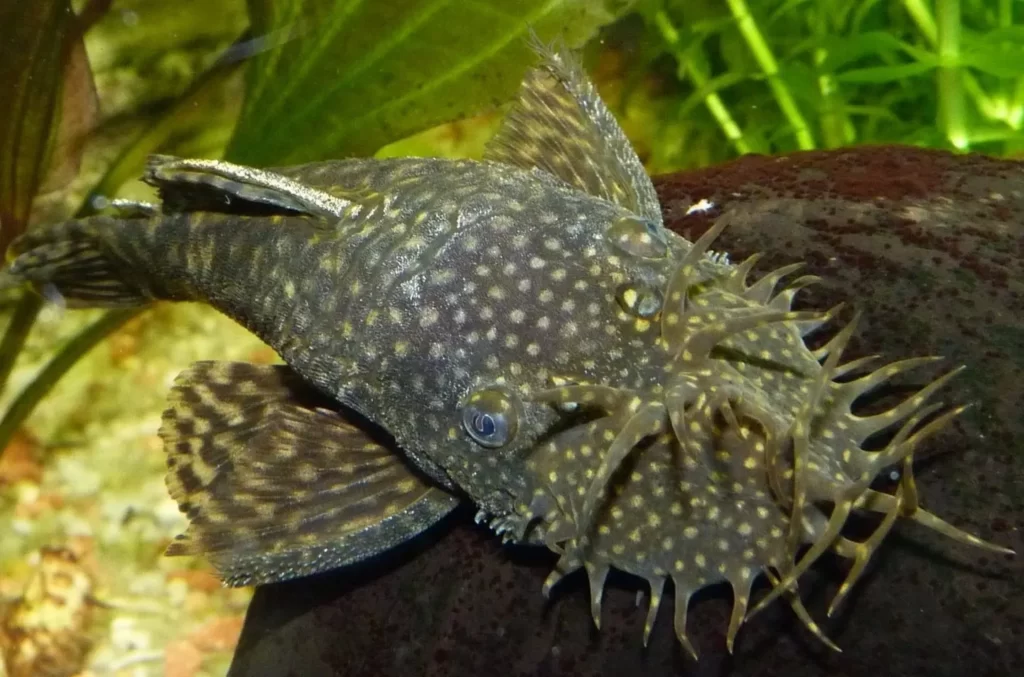
Moving on, another interesting type of sucker fish is the bristlenose pleco. These species can be kept in smaller aquariums, unlike the common pleco. Bristlenose plecos are easily identifiable by their small sprouts or tentacles hanging around from the top of their head.
| Aspect | Information |
|---|---|
| Scientific Name | Ancistrus cirrhosus |
| Origin | South America |
| Rarity | Common |
| Price | $5 - $15 USD |
| Care Level | Easy |
| Water Temperature | 22°C - 28°C (72°F - 82°F) |
| pH | 6.0 - 7.5 |
| Minimum Tank Size | 20 gallons |
| Diet | Herbivore - Algae, blanched vegetables, algae wafers, leftover food |
| Temperament | Peaceful |
| Lifespan | 5 - 10 years |
| Size | 4 - 5 inches |
Moving on, another interesting type of sucker fish is the bristlenose pleco. These species can be kept in smaller aquariums, unlike the common pleco. Bristlenose plecos are easily identifiable by their small sprouts or tentacles hanging around from the top of their head.
You might also like to read: 16 Types of Aquarium Snails You Should Have
Rubber Lip Pleco
Another pleco type that is also a sucker fish is the rubber lip pleco. The name suggests that these species have larger lips around their mouth, which can resemble the lips being made out of rubber.
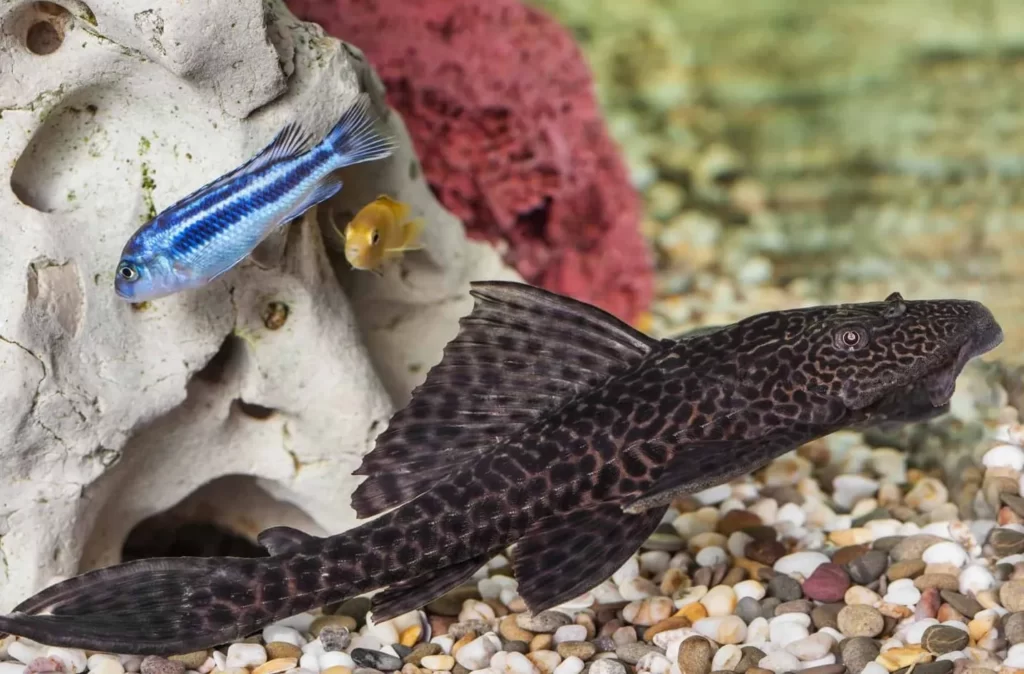
These species look nearly identical to the common pleco, and it can sometimes be hard to tell the difference between these two species. One thing to consider, is that rubber lip plecos don’t grow as large as common plecos, reaching only about 5 inches in length.
| Aspect | Information |
|---|---|
| Scientific Name | Chaetostoma milesi |
| Origin | South America |
| Rarity | Uncommon |
| Price | $15 - $25 USD |
| Care Level | Moderate |
| Water Temperature | 22°C - 28°C (72°F - 82°F) |
| pH | 6.5 - 7.5 |
| Minimum Tank Size | 30 gallons |
| Diet | Herbivore - Algae, blanched vegetables, algae wafers, leftover food |
| Temperament | Peaceful |
| Lifespan | 10 - 15 years |
| Size | 4 - 5 inches |
Rubber lip plecos are most interesting when you can actually see the mouth of the fish. These species occasionally will attach to the aquarium glass, making their big lips visible.
Clown Pleco
Moving on, another sucker fish type on this list is the clown pleco. These species are extremely beautiful, compared to the more basic types of plecos.

Clown plecos usually have white irregular stripes going across their body, something similar to a spiral pattern. The top fin of the fish usually is also partially white and black.
| Aspect | Information |
|---|---|
| Scientific Name | Panaqolus maccus |
| Origin | South America |
| Rarity | Uncommon |
| Price | $15 - $30 USD |
| Care Level | Moderate |
| Water Temperature | 24°C - 30°C (75°F - 86°F) |
| pH | 6.0 - 7.5 |
| Minimum Tank Size | 20 gallons |
| Diet | Herbivore - Algae, blanched vegetables, algae wafers, leftover food |
| Temperament | Peaceful |
| Lifespan | 5 - 10 years |
| Size | 3 - 4 inches |
These species are considered more uncommon than other sucker fish already mentioned on this list, simply because fewer people and aquatic stores breed them, making the supply of these fish lower than others.
Zebra Pleco
A very similar sucker fish to the clown pleco is the zebra pleco. This bottom-dweller is extremely expensive and can cost hundreds of dollars for a single pleco.

The zebra pleco is similar in appearance to a basic zebra – the whole body and fins of the fish are covered with thick white stripes, making it truly a unique type of sucker fish. They are extremely pricy due to the way how these species look.
| Aspect | Information |
|---|---|
| Scientific Name | Hypancistrus zebra |
| Origin | Brazil |
| Rarity | Rare |
| Price | $200 - $400 USD |
| Care Level | Advanced |
| Water Temperature | 24°C - 28°C (75°F - 82°F) |
| pH | 6.0 - 7.5 |
| Minimum Tank Size | 30 gallons |
| Diet | Herbivore - Algae, blanched vegetables, algae wafers, leftover food |
| Temperament | Peaceful |
| Lifespan | 10 - 15 years |
| Size | 3 - 4 inches |
There are not a lot of zebra pleco breeders available in this hobby. The main reason for that is that these species have the highest chance of breeding, if the conditions are perfect, and not every fishkeeper can create extremely precise conditions for breeding, only the ones who know the fish very well.
Vampire Pleco
Another relatively expensive and unique type of sucker fish is the vampire pleco. These species have larger teeth than most plecos, and the teeth are visible when the fish suctions itself on the glass.

Vampire plecos are usually black in body color and have a bunch of white dots scattered around the body and fins randomly. These species can also cost up to hundred dollars per fish.
| Aspect | Information |
|---|---|
| Scientific Name | Leporacanthicus galaxias |
| Origin | South America |
| Rarity | Rare |
| Price | $50 - $100 USD |
| Care Level | Moderate |
| Water Temperature | 24°C - 30°C (75°F - 86°F) |
| pH | 6.0 - 7.5 |
| Minimum Tank Size | 30 gallons |
| Diet | Herbivore - Algae, blanched vegetables, algae wafers, leftover food |
| Temperament | Aggressive if there is not enough space |
| Lifespan | 8 - 10 years |
| Size | 8 - 10 inches |
These species can be somewhat aggressive towards other sucker fish or bottom dwellers. If the aquarium is large enough, there are hiding spaces and different types of decorations in an aquarium, the vampire pleco will be a peaceful addition to a community tank.
You might also like to read: 7 Amazing Smallest Freshwater Shrimp You Should Keep
Golden Nugget Pleco
Moving on, another expensive sucker fish is the golden nugget pleco. These species can also cost up to a hundred dollars per fish, and the main reason for that is that they look absolutely amazing.
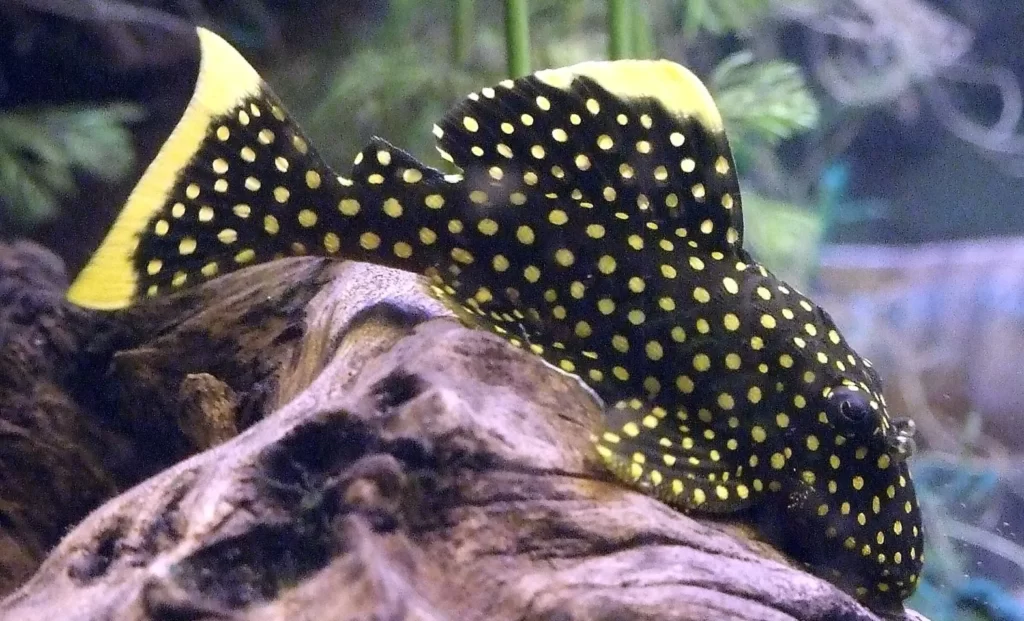
Golden nugget plecos can look somewhat similar to vampire plecos, the body is also black, but the dots in this case are bright yellow, and the golden nugget pleco also has fins, that are bright yellow at the very edges.
| Aspect | Information |
|---|---|
| Scientific Name | Baryancistrus xanthellus |
| Common Name | Golden Nugget Pleco |
| Origin | South America |
| Rarity | Uncommon |
| Price | $50 - $100 USD |
| Care Level | Moderate |
| Water Temperature | 24°C - 30°C (75°F - 86°F) |
| pH | 6.0 - 7.5 |
| Minimum Tank Size | 50 gallons |
| Diet | Herbivore - Algae, blanched vegetables, algae wafers, leftover food |
| Temperament | Peaceful |
| Lifespan | 10 - 15 years |
| Size | 6 - 8 inches |
Golden nugget plecos are more peaceful than vampire plecos. They can be a great addition to an aquarium, that has a darker setup since the yellow dots around the body would be more visible.
Sailfin Pleco
A larger sucker fish, that needs at least 75 gallons to keep, is the sailfin pleco. By the looks of it, it is a pretty basic species, with no interesting colors, but the distinctive feature is the top fin of the fish.

Sailfin plecos have an extremely large dorsal fin, which can resemble a sail on the ship, hence the name. In terms of the appearance of the sailfin pleco, the body looks similar to the common pleco, having a mixture of grey, brown, and black colors.
| Aspect | Information |
|---|---|
| Scientific Name | Pterygoplichthys gibbiceps |
| Common Name | Sailfin Pleco |
| Origin | South America |
| Rarity | Common |
| Price | $10 - $30 USD |
| Care Level | Easy |
| Water Temperature | 22°C - 28°C (72°F - 82°F) |
| pH | 6.5 - 7.5 |
| Minimum Tank Size | 75 gallons |
| Diet | Herbivore - Algae, blanched vegetables, algae wafers, leftover food |
| Temperament | Peaceful |
| Lifespan | 10 - 15 years |
| Size | 14 - 20 inches |
Sailfin plecos grow extremely large, reaching up to 20 inches when fully matured. This means that a larger aquarium is necessary to keep these species because a small environment can stunt the sailfin pleco growth.
Tiger Pleco
Another extremely unique sucker fish is the tiger pleco. These species have irregular yellow stripes covering their black body, making them look something similar to a tiger.
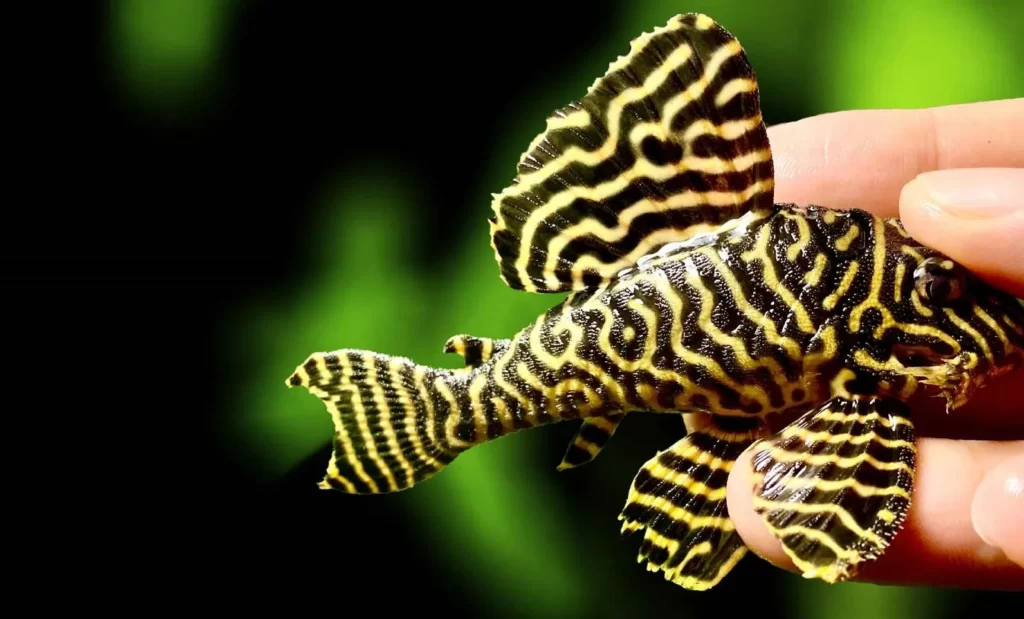
Tiger plecos can actually be kept in aquariums as small as 30 gallons. They grow to about 6 inches and don’t need too much space, compared to the larger types of sucker fish on this list.
| Aspect | Information |
|---|---|
| Scientific Name | Panaqolus sp. |
| Common Name | Tiger Pleco |
| Origin | South America |
| Rarity | Uncommon |
| Price | $30 - $50 USD |
| Care Level | Moderate |
| Water Temperature | 24°C - 29°C (75°F - 84°F) |
| pH | 6.5 - 7.5 |
| Minimum Tank Size | 30 gallons |
| Diet | Herbivore - Algae, blanched vegetables, algae wafers, leftover food |
| Temperament | Peaceful |
| Lifespan | 10 - 15 years |
| Size | 4 - 6 inches |
Similar to other more beautiful species on this list, tiger plecos would look better in darker aquarium setups. The yellow color of their stripes could create a contrast, and the fish would be very visible in a darker aquarium.
Snowball Pleco
Moving on, some people might easily confuse vampire plecos with snowball plecos. These species are slightly different, but also considered an amazing sucker fish, that can help clean the tank.
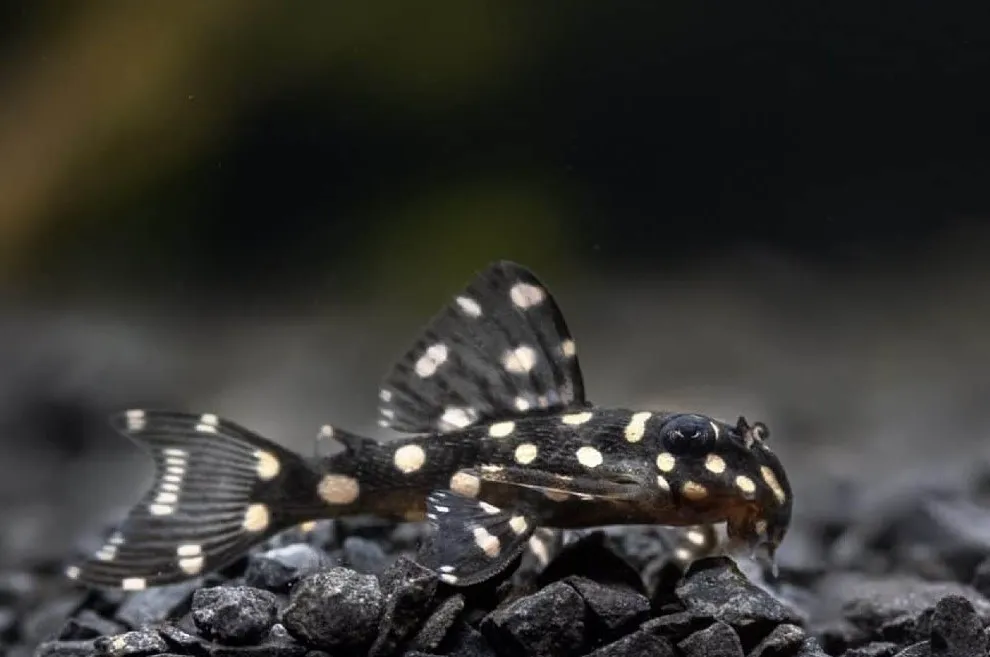
Snowball plecos also have white dots covering their whole black body, but unlike vampire plecos, the white dots on these species are way larger. Snowball plecos can also reach 6 inches in length, while vampire plecos are larger fish. and grow to 10 inches.
| Aspect | Information |
|---|---|
| Scientific Name | Hypancistrus inspector |
| Origin | South America |
| Rarity | Rare |
| Price | $50 - $100 USD |
| Care Level | Moderate |
| Water Temperature | 25°C - 30°C (77°F - 86°F) |
| pH | 6.0 - 7.5 |
| Minimum Tank Size | 30 gallons |
| Diet | Herbivore - Algae, blanched vegetables, algae wafers, leftover food |
| Temperament | Peaceful |
| Lifespan | 10 - 15 years |
| Size | 5 - 6 inches |
Snowball plecos essentially got their name based on their appearance. These species can easily resemble a fish covered in small snowballs. It is a very beautiful fish, that is usually more expensive than the more basic sucker fish on this list.
Butterfly Loach
Moving on, the first sucker fish, that is not a pleco, is the butterfly loach. These species have a compressed and round body shape, similar to a sting ray.
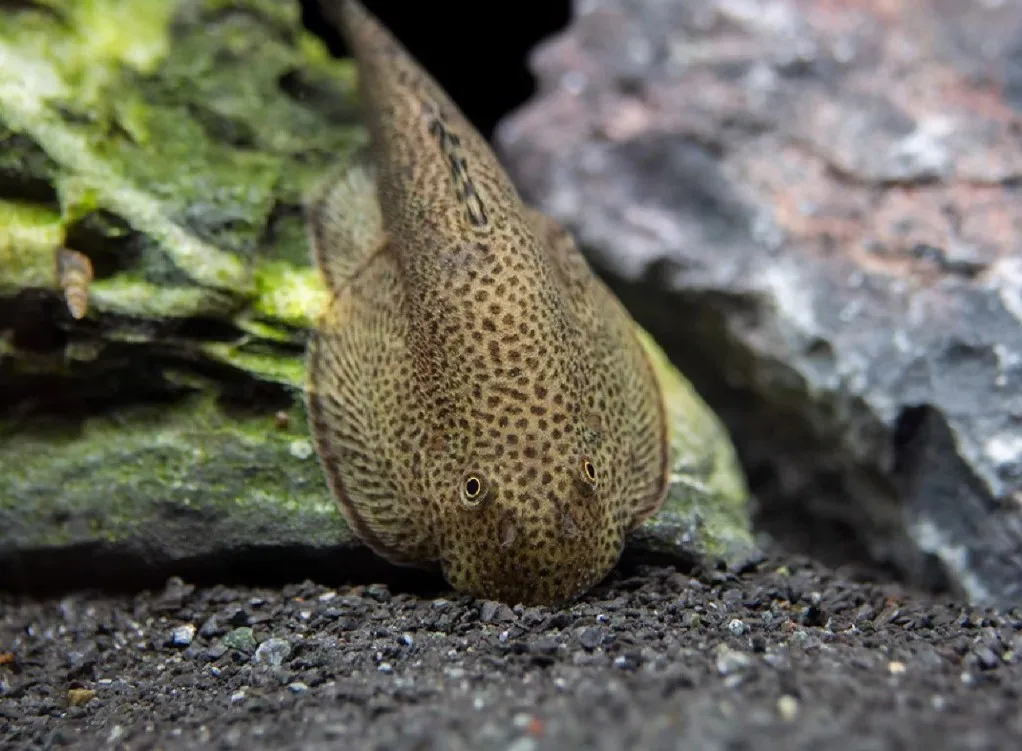
There are a lot of different types of butterfly loaches, some are more rare than others, but most of them have a camo-type pattern on their body, and are greenish or brownish in color. They also might have dark spots or small stripes covering their body.
| Aspect | Information |
|---|---|
| Scientific Name | Beaufortia kweichowensis |
| Origin | Asia - China, Vietnam |
| Rarity | Uncommon |
| Price | $5 - $10 USD |
| Care Level | Easy |
| Water Temperature | 18°C - 26°C (64°F - 79°F) |
| pH | 6.5 - 7.5 |
| Minimum Tank Size | 20 gallons |
| Diet | Herbivore - Algae, blanched vegetables, algae wafers, leftover food |
| Temperament | Peaceful |
| Lifespan | 5 - 8 years |
| Size | 3 - 4 inches |
Butterfly loaches are extremely peaceful, and are one of the smaller sucker fish species on this list. They also might be hiding a lot at first, since these species tend to be shy in a new environment.
Borneo Sucker
Another sucker fish that is very similar to the butterfly loach is the borneo sucker. It is almost identical in terms of appearance to the butterfly loach, but it has slightly different appearance features.

The borneo sucker is mainly native to the Borneo island in Asia, hence the name. These species are greenish or yellowish in body color and have black stripes and dots all around the body.
| Aspect | Information |
|---|---|
| Scientific Name | Gastromyzon punctulatus |
| Common Name | Borneo Sucker |
| Origin | Asia - Borneo |
| Rarity | Uncommon |
| Price | $15 - $30 USD |
| Care Level | Moderate |
| Water Temperature | 24°C - 28°C (75°F - 82°F) |
| pH | 6.0 - 7.5 |
| Minimum Tank Size | 20 gallons |
| Diet | Herbivore - Algae, blanched vegetables, algae wafers, leftover food |
| Temperament | Peaceful |
| Lifespan | 2 - 4 years |
| Size | 1.5 - 2 inches |
The borneo sucker is extremely small and is one of the tiniest sucker-type species available in this hobby. It is a peaceful yet shy fish, that loves lots of vegetation and hiding places.
Siamese Algae Eater
Another beautiful and unique species on this list is the siamese algae eater. These species are extremely good at cleaning up all sorts of algae in a fish tank, and that is the reason why so many people buy them.

The siamese algae eater is considered a semi-aggressive fish. In most cases, this fish is very peaceful with all other aquarium inhabitants, but at the same time it is an opportunistic species, it might go after smaller shrimp or crustaceans.
| Aspect | Information |
|---|---|
| Scientific Name | Crossocheilus oblongus |
| Origin | Southeast Asia - Thailand, Malaysia |
| Rarity | Common |
| Price | $3 - $7 USD |
| Care Level | Easy |
| Water Temperature | 22°C - 28°C (72°F - 82°F) |
| pH | 6.5 - 7.5 |
| Minimum Tank Size | 20 gallons |
| Diet | Herbivore - Algae, blanched vegetables, algae wafers, leftover food |
| Temperament | Semi-aggressive |
| Lifespan | 5 - 7 years |
| Size | 6 inches |
These species are very basic-looking fish. They are gray in body color and have a distinctive thick black stripe going from head to tail. Siamese algae eaters are also known for portraying schooling behavior, so be sure to get a couple of them.
Chinese Algae Eater
Another notorious algae eater is the chinese algae eater. It is a sucker fish, that can look somewhat similar to the siamese algae eater, but it is a completely different species.

These species can actually be slightly dangerous to other fish if there is not enough space in an aquarium. Chinese algae eaters are known for sucking the slime coat and damaging the fins of other fish. The odds of this happening can be reduced if there is enough territory for all inhabitants in an aquarium.
| Aspect | Information |
|---|---|
| Scientific Name | Gyrinocheilus aymonieri |
| Origin | Asia - China |
| Rarity | Common |
| Price | $3 - $8 USD |
| Care Level | Easy |
| Water Temperature | 22°C - 28°C (72°F - 82°F) |
| pH | 6.5 - 7.5 |
| Minimum Tank Size | 30 gallons |
| Diet | Herbivore - Algae, blanched vegetables, algae wafers, leftover food |
| Temperament | Semi-aggressive |
| Lifespan | 5 - 10 years |
| Size | 10 - 11 inches |
Chinese algae eaters look very similar to siamese algae eaters. They also have gray bodies with a distinctive black stripe going across the whole body, but these species grow almost twice bigger. There is also a yellow variant of the chinese algae eater, and it is called the golden algae eater, but it is essentially the same fish with different colors.
Featherfin Squeaker
The first omnivorous fish on this list is the featherfin squeaker. It is a unique sucker fish, that can actually make sounds to communicate with other fish of its kind, hence the interesting “squeaker” name.

Featherfin squeakers are also known for their interesting dorsal fin, that resembles a feather. These species are gray in body color and have black small dots covering their whole body. The fins are also slightly transparent but can have white and black markings on them.
| Aspect | Information |
|---|---|
| Scientific Name | Synodontis eupterus |
| Common Name | Featherfin Squeaker |
| Origin | Africa - Congo River Basin |
| Rarity | Common |
| Price | $10 - $20 USD |
| Care Level | Moderate |
| Water Temperature | 24°C - 28°C (75°F - 82°F) |
| pH | 6.0 - 7.5 |
| Minimum Tank Size | 30 gallons |
| Diet | Omnivore - plant matter, algae, leftover fish food, bloodworms, sinking pellets or algae wafers |
| Temperament | Semi-aggressive |
| Lifespan | 8 - 12 years |
| Size | 8 - 10 inches |
Featherfin squeakers are also semi-aggressive and can become bullies to other bottom-dwellers. They like to push around other fish if they come into their territory and also during feeding time. Nevertheless, if there is enough space, this fish will be just fine with other community fish species.
Striped Raphael Catfish
Moving on, another interesting sucker fish on this list is the striped raphael catfish. These species are extremely unique since they have the capability to produce sounds out of the water, which usually sound like something squeaking or grunting.

These species have a unique appearance: most of the body is covered in white and black stripes from head to tail. Striped raphael catfish also have significantly long whiskers or “mustaches”, that help navigate the aquarium.
| Aspect | Information |
|---|---|
| Scientific Name | Platydoras armatulus |
| Origin | South America - Amazon Basin |
| Rarity | Uncommon |
| Price | $15 - $30 USD |
| Care Level | Moderate |
| Water Temperature | 23°C - 28°C (73°F - 82°F) |
| pH | 6.0 - 7.5 |
| Minimum Tank Size | 30 gallons |
| Diet | Omnivore - plant matter, algae, leftover fish food, bloodworms, sinking pellets or algae wafers |
| Temperament | Peaceful |
| Lifespan | 5 - 8 years |
| Size | 6 - 8 inches |
This interesting catfish is a very social and peaceful creature. Most of the time it is active mainly during the night since the striped raphael catfish is extremely nocturnal.
Royal Farlowella
Moving on, an extremely unique sucker fish in terms of appearance is the royal farlowella. These species are also known as the twig catfish due to their long and slim body.

The royal farlowella is a sucker fish, that is mainly peaceful and can do well in most community tanks. It has a very long tail, while the body is covered in black and white spots. These species also have a large dorsal and tail fin, which is a unique appearance trait for these species.
| Aspect | Information |
|---|---|
| Scientific Name | Sturisoma panamense |
| Common Name | Royal Farlowella |
| Origin | South America |
| Rarity | Uncommon |
| Price | $15 - $25 USD |
| Care Level | Moderate |
| Water Temperature | 22°C - 28°C (72°F - 82°F) |
| pH | 6.5 - 7.5 |
| Minimum Tank Size | 30 gallons |
| Diet | Herbivore - Algae, Specially Prepared Foods |
| Temperament | Peaceful |
| Lifespan | 5 - 8 years |
| Size | 8 - 10 inches |
The royal farlowella is mainly a herbivore, that loves to eat all sorts of algae and plant matter. Even though these species are herbivores and peaceful fish, they might also be opportunistic, and eat small shrimp fry or other tiny crustaceans.
Lizard Catfish
Moving on, another twig-like sucker fish is the lizard catfish. It is a very similar catfish species to the royal farlowella, but differs in size and appearance.

The lizard catfish is twice as small as the royal farlowella, and is usually orange in color. These species can easily resemble a small lizard, by simply looking at their body and finds from above.
| Aspect | Information |
|---|---|
| Scientific Name | Rineloricaria spp. |
| Origin | South America |
| Rarity | Uncommon |
| Price | $10 - $20 USD |
| Care Level | Easy |
| Water Temperature | 22°C - 28°C (72°F - 82°F) |
| pH | 6.5 - 7.5 |
| Minimum Tank Size | 20 gallons |
| Diet | Herbivore - Algae, blanched vegetables, algae wafers, leftover food |
| Temperament | Peaceful |
| Lifespan | 5 - 8 years |
| Size | 4 - 6 inches |
These species are extremely peaceful, and would probably look in darker aquariums better due to their body coloration. Even though they are not particularly expensive, these species are quite hard to find in the aquarium hobby.
Loricaria
The last species on this list is loricaria. It is another fish, that looks like a twig due to its slim body and long tail. It is a very shy fish, that loves to hide during the day and mainly lives during the night.

In terms of appearance, loricaria has three pectoral fins on both sides of the body, and the coloration of the fish can vary from different family species. There are a lot of different types of loricaria, some are more unique than others.
| Aspect | Information |
|---|---|
| Scientific Name | Loricaria spp. |
| Origin | South America |
| Rarity | Uncommon |
| Price | $15 - $30 USD |
| Care Level | Moderate |
| Water Temperature | 23°C - 28°C (73°F - 82°F) |
| pH | 6.0 - 7.5 |
| Minimum Tank Size | 30 gallons |
| Diet | Omnivore - plant matter, algae, leftover fish food, bloodworms, sinking pellets or algae wafers |
| Temperament | Peaceful |
| Lifespan | 5 - 8 years |
| Size | 4 - 6 inches |
Loricaria males can also develop short sprouts or “beards” on their faces, making it way easier to identify these species. Since this fish is quite unique, there are not many fish stores, that have loricaria in their stock.
Frequently Asked Questions
Do Sucker Fish Eat Algae?
Most suckermouth fish are herbivores, which means, that they love to eat all sorts of algae! Nevertheless, there are a couple of sucker fish types, that are omnivorous, which means that algae can’t fully sustain their diet, and they don’t eat algae all the time.
Do Sucker Fish Eat Plants?
Some sucker fish might nibble on softer plants in an aquarium, while most of them just eat decaying plant matter. Although suckermouth fish are notorious for uprooting some aquarium plants, so be sure to get some column-feeding aquarium plants to avoid this problem.
Writer's Thoughts
Sucker fish are very interesting species to have in an aquarium. They are very fun to watch since not so many fish actually enjoy sticking to an aquarium or eating algae. They are a good addition if you have algae problems in your aquarium.
If you enjoyed reading our article, please feel free to share it with your friends by clicking the social media buttons below:





